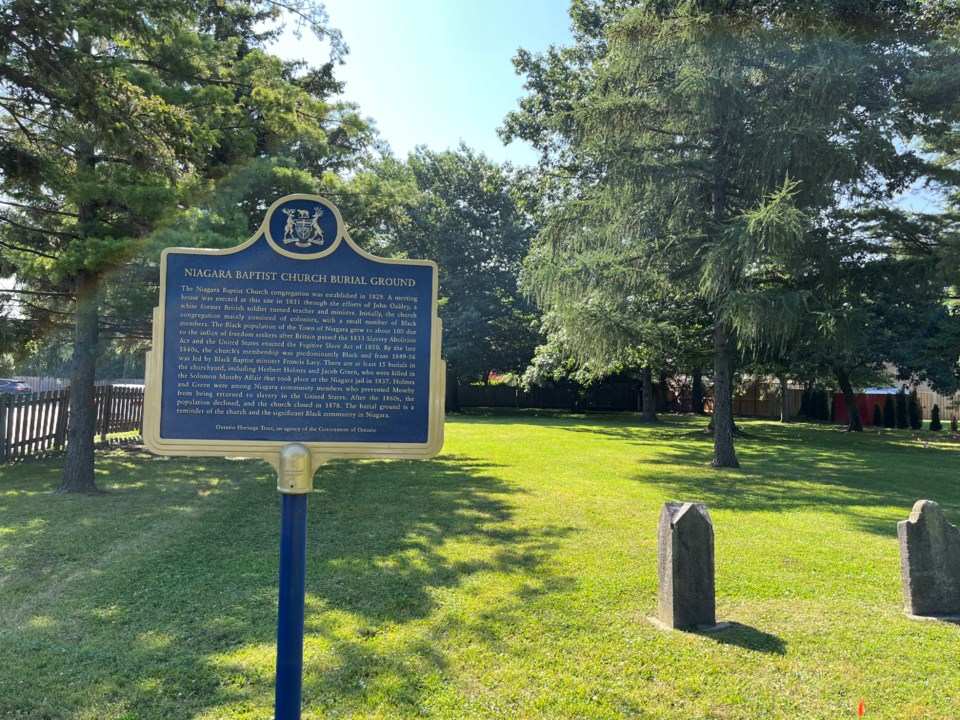A well-known researcher of Black history in the region is urging Niagara-on-the-Lake town council to refuse the offer of a proposed monument at the Negro Burial Ground.
During last week’s council meeting, Rochelle Bush, a trustee and historian at Salem Chapel British Methodist Episcopal Church, a national historic site related to the Underground Railroad and Harriet Tubman, told councillors and staff that the ‘Memorializing the People of the Fugitive Slave Ads: Barbados and Niagara’ is “historically inaccurate.”
The ideas behind this memorial “re-imagine the history and the facts by falsely connecting the history of enslaved people of African descent who resided in Barbados to the history of enslaved people” who resided in Niagara-on-the-Lake, under the guise of the African diaspora, said Bush in her presentation.
Descendants of West Africans were forced into slavery and dispersed throughout the Americas, she continued.
“Their lived experiences were very different,” Bush told council.
The majority of early Black residents in Niagara-on-the-Lake were from the U.S., and many were brought as slaves from the United States by White Loyalists.
Others were Black Loyalists who were once enslaved in the U.S., said Bush.
“A memorial that re-writes the narrative by connecting the history of enslaved people in Barbados to the history of enslaved people in Niagara-on-the-Lake” is incorrect, and also reduces the importance of the town’s own early Black history, involving residents such as Herbert Holmes and Jacob Green, she said.
The town’s early Black history is the “only Black history that should be included in a memorial.”
Niagara-on-the-Lake “does not appear to take centre stage in the memorial sculpture,” she added.
If a partnered memorial with another country such as Barbados is permitted at the cemetery, then “all the other African diaspora countries should be recognized with a memorial as well,” said Bush, who also told council that the group behind the project asked for her to contribute research, but she denied the request.
Lissa Paul, a Brock University professor who is part of the team proposing the monument, said in a statement that the Niagara-on-the-Lake project involving African-Canadian sculptor Quentin VerCetty has “no links at all to the history of enslavement in Barbados.”
The connection was on the “way archival research can result in bringing the lived experience of people to public consciousness and to act as a corrective to historical wrongs,” said Paul, also providing further explanation about how the idea came to be.
“The NOTL project itself came out of work I did in Barbados on a British Library Endangered Program Archives grant to digitize two Barbadian newspapers from the 18th and early 19th centuries,” said Paul.
Those papers served as the core of two projects: a massive crowdsourcing project on “agents of enslavement” and on a series of daily podcasts, wrote Paul.
“The concept for the project also came out of a discussion with Alissandra Cummins, who is the director of the Barbados Historical Society, and has a long affiliation with the UNESCO Memory of the World project,” she added.
Paul said she and her team were made aware “that the legacy of the archival work in Barbados may have caused confusion,” resulting in the group changing a description of the project on its website.
“Our project originated with work done in Barbados on the recovery of people memorialized in the fugitive slave ads, then evolved in Niagara as a way of remembering and honouring the people of African descent who lived, worked, worshipped, educated their children, contributed — and died — in the region in the late eighteenth and early nineteenth centuries,” it reads now.
Council voted to refer Bush’s decision to the town’s heritage committee and staff for further consideration.
In June, stage 1 of an archaeological assessment of the Negro Burial Ground was completed.
This assessment, commissioned by the town and funded through Friends of the Forgotten, a town fundraising committee, is the first step in mandatory due diligence required by the Bereavement Authority of Ontario in advance of potential improvements to the property, said a news release.
The study, conducted by Archaeological Research Associates, includes information about the geography and history of the area, the archaeological potential of the site, and strategies to proceed to stage 2.
